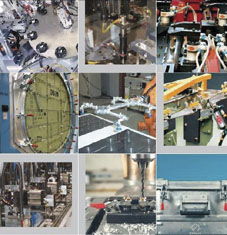Cylinder selection
Proper cylinder selection is the most critical factor in any workholding system. The shape and size of the workpiece and the machining process involved will determine the type and size of cylinders most suitable for the job. A range of production tooling cylinders are available for various tasks: ● Positioning and push cylinders guide the workpiece and push it securely into the desired position. ● Down-holding cylinders, including swing cylinders and edge clamps, clamp the positioned workpiece firmly to the fixture or worktable. ● Pull cylinders, some available with hydraulic or spring return, clamp the workpiece or fixture in applications requiring pull forces. ● Work support cylinders maintain the workpiece accurately on the prescribed plane during machining. Swing cylinders and work supports often are used in combination for a variety of workholding applications. Swing cylinders typically are used as clamping components in applications requiring unrestricted loading and unloading. Providing maximum clamping force in a small package, they enable unobstructed part fixturing and placement. A swing cylinder's rod and attached clamp arm rotate 90 degrees in clockwise or counterclockwise directions, then travel down an additional distance to clamp against the fixtured part. When the clamping pressure is released, the clamp arm rotates 90 degrees in the opposite direction to allow for part removal and new-part placement. Different mounting options and operation styles enable users to select components to suit almost any application. Varieties include upper- and lower-flange swing cylinders, as well as threaded-body and cartridge-model swing cylinders. Different sizes and styles of clamp arms also are available. When the machining operation requires positive hydraulic return action, double-acting cylinders can be specified because they provide a fast release time to help increase output. If spring-return action is sufficient, single-acting cylinders or a combination of single-acting and double-acting units can be used.
A swing cylinder's rod and attached clamp arm rotate 90 degrees in clockwise or counterclockwise directions, then travel down an additional distance to clamp against the fixtured part. When the clamping pressure is released, the clamp arm rotates 90 degrees in the opposite direction to allow for part removal and new-part placement. Different mounting options and operation styles enable users to select components to suit almost any application. Varieties include upper- and lower-flange swing cylinders, as well as threaded-body and cartridge-model swing cylinders. Different sizes and styles of clamp arms also are available. When the machining operation requires positive hydraulic return action, double-acting cylinders can be specified because they provide a fast release time to help increase output. If spring-return action is sufficient, single-acting cylinders or a combination of single-acting and double-acting units can be used. Cylinder force and stroke
The size and shape of the workpiece and the designated machining operation generally determine the cylinder force and stroke, as well as the size and style of work supports. Still another influence is the work space or clearance around the job at hand. During fixture design, several features of swing cylinders and work supports should be taken into consideration. Perhaps the most important is the amount of support force needed, which, in turn, will influence the size of the work support. In principle, the work support must overcome both the clamping forces and the machining forces, including those that may be generated by vibrations. Usually the clamping force applied to the work support should not exceed 50 percent of its capacity at a given operating pressure. For many applications, this is sufficient to absorb additional forces, such as machining forces. The 2-to-1 safety factor may need to be increased to 4-to-1 if extreme vibration or an interrupted cut is part of the application. The recommended ratio between clamping force and support forces can be achieved by selecting the right sizes of clamping components or by operating the swing cylinder and the work support with different operating pressures.Power source selection
Whether parts are needed once a day or 24 hours a day, the power source for an automatic workholding system should be carefully, accurately matchedNew Balance













